 | ||
|
Old Japanese candy shop (summer, 2006) Here is a sketch I did back in my neighborhod on the east side of Tokyo. It is a "dagashiya-san" which is basically a candy shop with an old time atmosphere. The neighborhood dagashiya-san has changed very little over the years, and adults can are surprised to walk in with their kids and find the same variety of candy and toys that existed when they were kids -- and still at amazingly low prices. 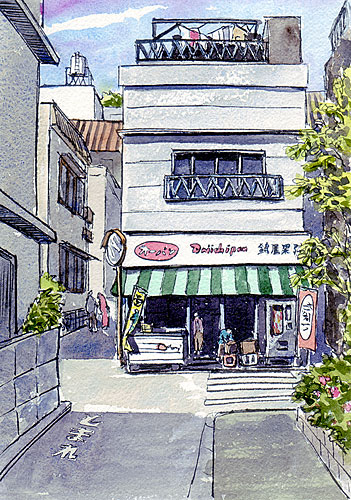 You can't find these candies at any other shop, which is one reasons these little neighborhood shops have not gone extinct. I suppose one reason for the amazing low prices is the small portions and the low quality of the candy. I bought some chocolate there and found it to have practically no taste. But for a little kid who has nothing but a ten yen coin, the ability to go in by yourself and buy several pieces of candy is like heaven. All the neighborhood kids gather at these places. I got here in the late afternoon, and learned that my 9 year old daughter had left this shop with her friends just minutes before I had arrived. These shops are so popular that you can now find them in modern shopping malls, but they are still decorated to resemble something out of the 1950s since that old nostalgic atmosphere is the reason for their popularity. Like many neighborhood shops, this one is run by an old widow who lives on premises above the shop. You can even see laundry hanging on the roof. When there are no customers the owner sits in a back room just behind some curtains to watch television. Painted in red above the entrance is the logo and name of "Dai-ichi Pan" which is a bread company that financed the store sign. On the street to the left is painted "TOMARE" which means stop. This sketch was done with brush and ink plus watercolor. The train line that connects my neighborhood with the rest of Tokyo (and Japan) is called a subway although it runs above ground as it leaves central Tokyo. As a matter of fact by the time it reaches my neighborhood, it's elevated high above the street. The local station for this line actually spans a river! I think it's the only station in Japan that is built over a river. As you wait for the train you can look out the window and see the Kyu (old) Nakagawa River below. This was the most prominent river in Tokyo during the Edo era, but was reduced to a fraction of its original size when the Arakawa River was built nearby. 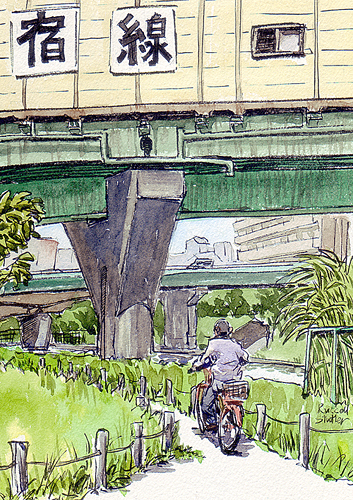 A small park runs along both banks of the Kyu Nakagawa, and under the station. The place where I stood as I looked up at the station would have been under water during the Edo era. Since the Nakagawa winds through much of Tokyo's east side, many bridges span it, and three are visible from this spot, beyond the station. You can see the last two kanji for the sign which identifies this train line as the Shinjuku line. On rainy days I have stood under the shelter this station to sketch what I could see from there. This is a very peaceful spot, but it can get very noisy when the trains run overhead.This sketch was done with brush and ink plus watercolor. This is Kanda Jinja (Jinja means shrine). I had heard about this shrine, and knew it was a big one somewhere in Central Tokyo just north of the Ochanomizu area, but despite the fact I had roamed all over the area I had never found it until now. It is a very impressive place. 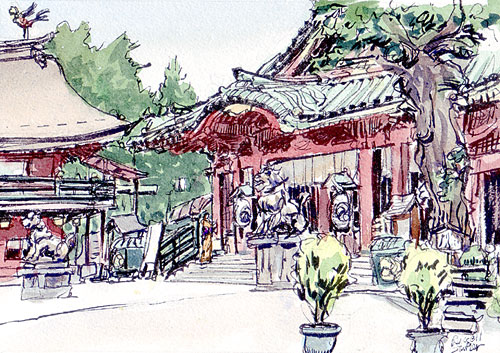 All the standard jinja elements were there including the shishi guarding the front and the large paper lanterns on both sides of the entrance. As I sketched, several people came up behind me to watch silently. One old man told me that this was a very popular place for sketchers. I sketched this during rainy season on one of the few days when it wasn't raining. However it rained soon after I left. This sketch was done with brush and ink plus watercolor. The following week I went back to the old part of Tokyo called Asakusa. I love this area, as I have mentioned before. If you ever visit Tokyo make sure you visit Asakusa to get a glimpse of old Tokyo. It's best if you take a bus or taxi (rather than the subway) into the area so you can see the old houses in the surrounding neighborhood as well. This is one of the shrines on the Sensoji temple grounds. Sensoji is another way to read the kanji for "Asakusa" and I suspect there is some kind of humor there somewhere. I've sketched this shrine before. As a matter of fact, the shishi on the right is the mate of the shishi on page 2. 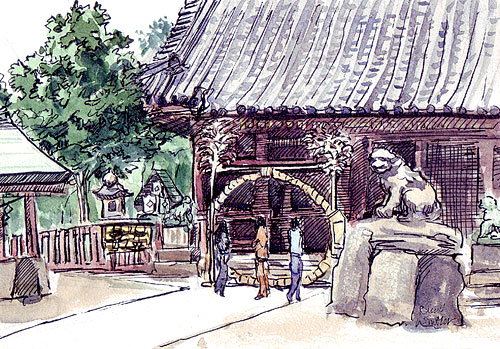 During early summer all the shrines seem to have these huge hoops made of woven grass standing in front of the entrance. They apparently are intended to bring good luck to those who pass through them. As I sketched this the woman at the left of it passed through it several times in a row. The shrine in my own neighborhood had a row of about a dozen loops set up, resembling a tunnel. I guess that would save time and energy since you could pass through them all in a row. This sketch looks a lot like the one of Kanda Jinja above, but I reversed the order of sketching. This sketch was done with brush and ink plus watercolor. I painted it in watercolor first and then went over it in ink. Actually, I think the results are the same except some of the ink lines are more defined since they are not coated with paint. And maybe the ink lines are slightly more loose in this one since they didn't have the task of defining the subject. Pink yagata-bune on the Arakawa On my sketching days sometimes I take a train into town, and sometimes I walk down to the Arakawa river to sketch the boats, one of my favorite subjects. This is another "yagata-bune" or a party boat, a pink one. At night dozens of these boats filled with happy guests go cruising up and down Tokyo's many rivers. Not only do they leave their cares behind for the evening, they also leave the land behind! 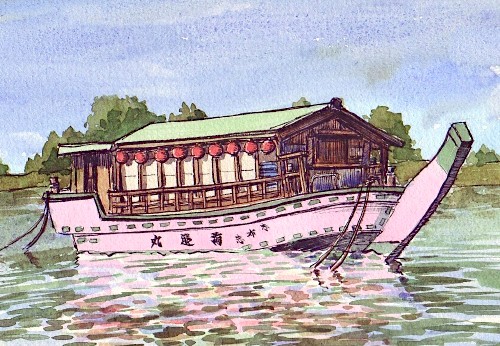 If you go to Odaiba, which is Tokyo's new shopping and recreation area on the bay, you will see dozens of yagata-bune with their twinkling lanterns appear in the harbor as the sun goes down. During the day, these boats are docked, where they are cleaned and prepared for another evening's revelry. This pink yagata bune is all ready to go, and waits for the sun to set. You can see a stack of blue zabuton (cushions) in one of the windows. This sketch was done with brush and ink plus watercolor. |
Next page >> |
 |